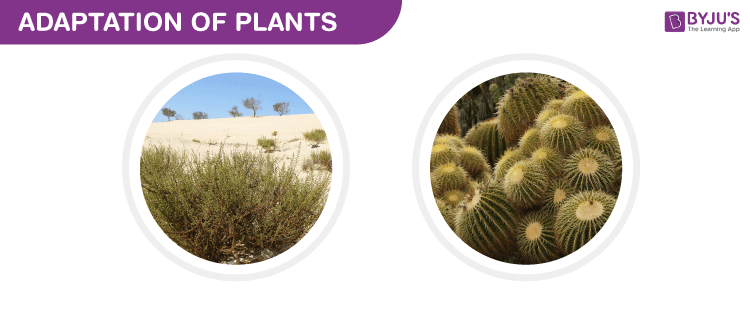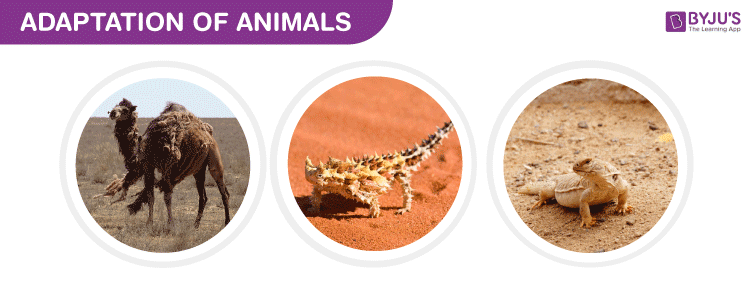Deserts are barren areas of land characterised by extremely high or low temperatures, with low rainfall and scarce or no vegetation.
Deserts are examples of terrestrial ecosystems, which are found throughout the world. Neither all deserts are flat, nor do all deserts have cacti or oases. These are regions with a short rainy season. It is scorching in the daytime, and very cold at night in the desert.
Explore more: Terrestrial Ecosystem
Let us explore more about the types and features of some desert ecosystems.
Types of deserts
Deserts are arid regions with especially low or high temperatures and limited vegetation. Based on the climate condition, deserts are classified into two types – hot deserts and cold deserts.

- The hot and dry desert – Sahara
The Sahara is known as the world’s largest desert, covering over 8.54 million square kilometres. It is the largest, and the hottest desert in the world.
Sahara desert is located in tropical regions, which are 1,000 m above sea level. It covers a huge part of North Africa, and eleven other countries – Algeria, Tunisia, Egypt, Mali, Chad, Niger, Western Sahara, Sudan, Mauritania, Libya and Morocco.
The total area actually measures about 8,600,000 square kilometres, which is 4,800 km approximately from east to west, and between 800 and 1,200 km from north to south.
The climate in this region is extremely hot, sizzling, and dry, and often receives small quantities of precipitation throughout the year.
In this hot desert, the days are scorching. During the day, temperatures will rise as high as 45° C to 50° C, heating the bare rocks and the sand. The nights can be extremely cold, with temperatures going below 0° C, sometimes.
- The cold and dry desert of Ladakh
Ladakh is famously known as the cold desert of India. It is found in the high altitudes of the temperate regions, which lie in the Great Himalayas within the eastern parts of Jammu and Kashmir and located in the western Himalayas region, within Himachal Pradesh in North India.
The altitude in Ladakh ranges from about 3,000 m in Kargil to 8,000 m in Karakoram. Due to its high altitude, the climate remains extremely cold and dry. The day temperatures in summer are just above 0° C and the night temperatures go below –30° C.
The Gangotri glacier along with several other glaciers are found here, along with different rivers flowing through Ladakh. Among the rivers, Indus is the most important river that flows through Ladakh.
In Ladakh, there are very few, tiny patches of grasses and shrubs for animals to graze on. Many poplars, groves of willows and shrubs of the genus Salix are seen in the valleys.
Features and Desert Habitats
The most determining feature of this terrestrial ecosystem is the amount of precipitation it receives, which is the least compared to other ecosystems.
A desert is an arid or bone-dry region of the landscape where there is little precipitation, hence living conditions are unfavourable for both flora and fauna. This ecosystem can exist from the Arctic to the tropics. Not all deserts are hot – some are often windy, while some contain rocks and others have sand dunes. Flora is a very rare but highly adaptive animal species and insects are found here.
The soils of the Sahara desert are low in organic matter and are often biologically inactive. The vegetation in the desert’s ecosystem is generally sparse with scattered concentrations of grasses, cacti, date palms and acacia.

Because of the extreme dryness and freezing cold in Ladakh, the vegetation is sparse. During the summer season, beans, turnips, potatoes, peas are sometimes cultivated. Fruit trees such as apricots, apples, and walnuts bloom in cold deserts.
Camels, foxes, jackals, owls, hyenas, wild goats and sheep, vultures, scorpions, ostriches, yaks, hawks, and desert reptiles including varieties of snakes and lizards, are the prominent animal species (fauna) of this terrestrial ecosystem.

Explore more: Adaptations of Animals In Deserts
This article concludes with an introduction to the desert ecosystem.
To know more about the desert ecosystem, its features, important questions and other related topics, keep visiting our website at BYJU’S Biology.
Comments